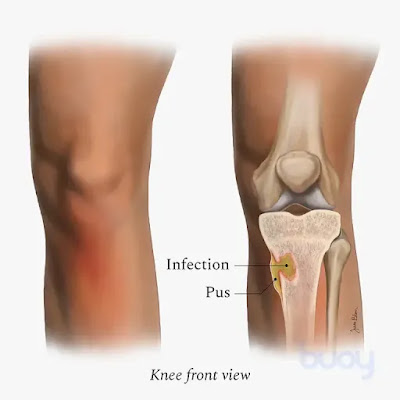Friday, May 5, 2023
Bone & Joint Infections
If bacteria enter the body, they can find their way to the musculoskeletal system, leading to infection. Bone and joint infections, also known as musculoskeletal infections, occur most commonly in toddlers and young children. They often occur in the bones and joints of the arms and legs. An infection of the bone is called osteomyelitis and septic arthritis refers to a joint infection.
Bone and joint infections are usually caused by bacteria called Staphylococcus aureus (or “staph”) and require treatment with antibiotics. A serious form of staph known as methicillin-resistant Staphylococcus aureus (MRSA) causes infections that can be more severe and need special antibiotics to treat.
It is important to recognize and treat bone and joint infections because they can:
Spread to the blood and other organs causing life-threatening illness
Damage growth plates, bones and joints
Cause chronic arthritis and bone fractures
Symptoms of bone and joint infections may include:
Pain (localized or vague) in a limb or joint that increases in severity
Pain with bearing weight on the affected limb or joint
Pain with touching the affected area
Redness and swelling at the site of pain
Redness and swelling of the joint
Warmth and redness in the infected area
Fever
Fatigue
General malaise
Diagnosis of Bone & Joint Infections
Pediatric infectious disease specialists at Riley at IU Health diagnose children with symptoms of an infection using the following tests:
Physical exam. This is a routine test that doctors use to assess health.
Blood test. This test examines a sample of blood.
X-ray. This test produces images of the inside of the body to help identify possible areas of infection.
Computed tomography (CT). This special X-ray produces cross-sectional images of the body to see if certain areas of the body are infected.
Magnetic resonance imaging (MRI). This test produces images of the inside of the body to see if there is inflammation in the infected areas. Some children may need diagnostic and interventional anesthesia for this test.
Once an experienced pediatrician or pediatric orthopedist determines that your child has a bone or joint infection, a procedure may be required to obtain a sample from the infected area. In the case of joint infections, fluid is aspirated using a needle and sent for laboratory analysis. Infections of the bone may require a bone biopsy (tissue sample taken from the body and examined) to help identify what specific bacteria have infected the bone. These procedures help decide the appropriate antibiotic for that type of bacterial infection. Occasionally, orthopedic surgery is required in cases of complicated musculoskeletal infections.
Treatments
If your child has a bone or joint infection, he or she needs to be treated by an experienced pediatric infectious disease specialist as well as a pediatric orthopedic surgeon. If infections are identified and treated early, most children have a good outcome.
Bone and joint infections are treated with intravenous (IV) antibiotics during a short hospital stay. After leaving the hospital, most children take oral antibiotics, usually for several weeks.
Some children may need a special IV called a peripherally inserted central catheter (PICC) line. A PICC line provides intravenous access for a prolonged period of time so the child can continue to receive IV antibiotics at home.
Treatment should include follow-up with a pediatric infectious disease specialist and a pediatric orthopedist.
Bone and joint infections, also known as musculoskeletal infections, occur most commonly in toddlers and young children.
Bone and joint infections are usually caused by bacteria called Staphylococcus aureus (or “staph”) and require treatment with antibiotics.
When treated early, most children with bone and joint infections have a positive outcome.
Some complicated cases of musculoskeletal infections may require orthopedic surgery.
Support Services & Resources
Find more information about award-nomination by visiting these trusted websites.
Nomination Link: https://x-i.me/ortawr21
Bone & Joint Infections Research
The Infectious Diseases Department and the Radiology & Imaging Department at Riley at IU Health are conducting research on the most effective diagnostic methods for musculoskeletal infections.
visit:https://orthopedic-conferences.pencis.com/
#BoneInfections #JointInfections #Osteomyelitis #SepticArthritis #Discitis #Bursitis #InfectionPrevention #Antibiotics #Surgery #Microorganisms #MedicalConditions #Diagnosis #Treatment #RiskFactors #WoundCare #Hygiene #IntravenousDrugUse #WeakenedImmuneSystem #MRI #Xray #CTscan #BloodTests #Pus #Abscesses #InfectedTissue #Complications #LongTermDisability
Subscribe to:
Post Comments (Atom)
Impingement
Impingement refers to a medical condition characterized by the compression or pinching of soft tissues, such as tendons or bursae, between ...
.png)
-
Fracture healing and bone repair are postnatal processes that mirror many of the ontological events that take place during embryonic develop...
-
Bankart repair with remplissage is a surgical technique used to address recurrent shoulder dislocations in the presence of Hill-Sachs lesion...
-
Oncology is a branch of medicine that specialises in the study, treatment, and management of cancer. It covers the entire scope of treatment...

.png)


No comments:
Post a Comment